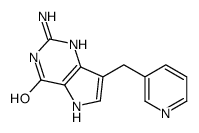| Description |
Peldesine (BCX 34) is a potent, competitive, reversible and orally active purine nucleoside phosphorylase (PNP) inhibitor with IC50s of 36 nM, 5 nM, and 32 nM for human, rat, and mouse red blood cell (RBC) PNP, respectively. Peldesine is also a T-cell proliferation inhibitor with an IC50 of 800 nM. Peldesine has the potential for cutaneous T-cell lymphoma, psoriasis and HIV infection treatment[1][2][3][4].
|
| Related Catalog |
|
| Target |
IC50: 36 nM (Human RBC PNP), 5 nM (Rat RBC PNP), 32 nM (Mouse RBC PNP), and 800 nM (Human T-cell proliferation)[3] Ki: 23 nM (Human RBC PNP)[3] HIV[4]
|
| In Vitro |
Peldesine (BCX 34; 0-50 µM; 72 hours; Jurkat cells) could inhibit the T-cell proliferation completely at a concentration of less than 10 μM, in the presence of dGuo (10 μM). In contrast, the B-cell proliferation is not affected by Peldesine[1]. Peldesine (BCX 34) suppresses T-cell immune reaction in an IL-2-independent manner, and this means that Peldesine might affect a late phase rather than an early stage in T-cell activation[1]. Peldesine also, in the presence but not in the absence of deoxyguanosine, inhibits human leukemia CCRF-CEM T-cell proliferation with an IC50 of 0.57 μM but not rat or mouse T-cell proliferation up to 30 μM[3]. Cell Proliferation Assay[1] Cell Line: Jurkat cells Concentration: 0 µM, 10 µM, 20 µM, 30 µM, 40 µM, 50 µM Incubation Time: 72 hours Result: In the presence of 10 µM dCuo, had a complete inhibitory effect for T-cell lines.
|
| In Vivo |
Oral bioavailability of Peldesine in rats is 76%. Peldesine is orally active in elevating plasma inosine in rats (2-fold at 30 mg/kg), in suppressing ex vivo RBC PNP activity in rats (98% at 3 h. 100 mg/kg), and in suppressing ex vivo skin PNP in mice (39% at 3 h, 100 mg/kg)[3].
|
| References |
[1]. Wada Y, et al. BCX-34: a novel T-cell selective immunosuppressant: purine nucleoside phosphorylase (PNP) inhibitor. Artif Organs. 1996 Aug;20(8):849-52. [2]. Duvic M, et al. A phase III, randomized, double-blind, placebo-controlled study of peldesine (BCX-34) cream as topical therapy for cutaneous T-cell lymphoma. J Am Acad Dermatol. 2001 Jun;44(6):940-7. [3]. Bantia S, et al. In vivo and in vitro pharmacologic activity of the purine nucleoside phosphorylase inhibitor BCX-34: the role of GTP and dGTP. Immunopharmacology. 1996 Oct;35(1):53-63. [4]. New AIDS study suppresses T cells to stop viral growth. AIDS Alert. 1997 Jul;12(7):77-8.
|
